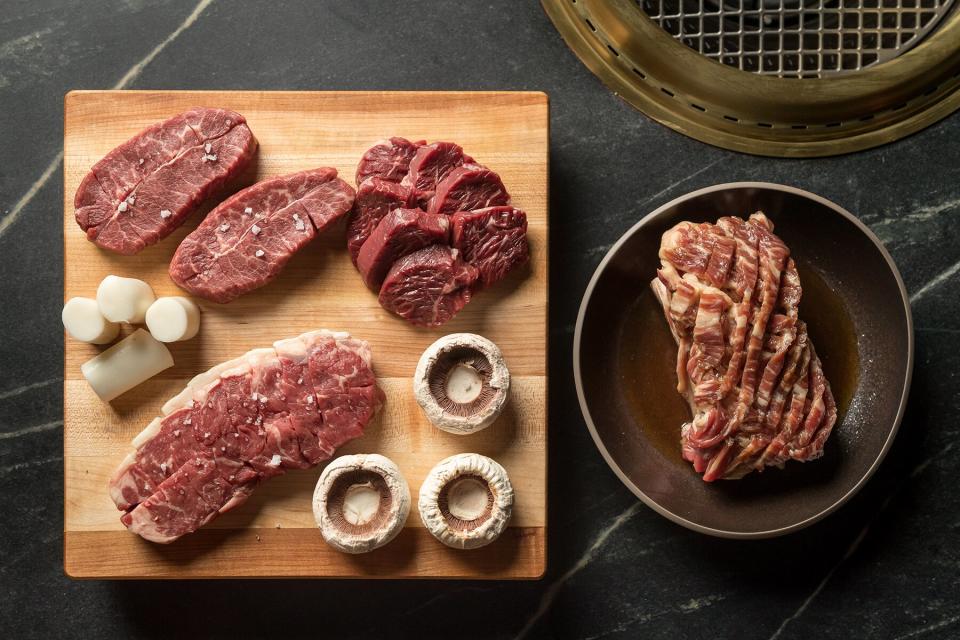How to Cook the Perfect Steak at Home, According to Top NYC Chefs

Noah Fecks/Courtesy Porter House Bar and Grill
It's not surprising that some of the country's most-beloved restaurants are steakhouses. The atmosphere is lively and luxurious, and a great steakhouse is perfect for a celebratory dinner. But sometimes, you'd rather have that celebration at home — whether to save money, or simply because you don't want to change out of sweatpants. And there's no reason you can't enjoy a luxe steakhouse moment while staying in.
To help you along, Travel + Leisure asked some of New York City's top steakhouse chefs how to make the perfect steak at home. Whether you're looking to whip up your own rib-eye, T-bone, or porterhouse, these pro tips will help turn your very own kitchen or dining room into a steakhouse.

Courtesy of Cote
Finding the Right Cut of Meat
It's hard to make steakhouse-quality steaks without buying steakhouse-quality cuts. If you're attempting to recreate your favorite slab at home, you'll need to take a trip to your local butcher. Steakhouses typically use the finest cuts of beef (like USDA Prime or Wagyu) that you might not find at your local grocery store.
Another perk of buying from a butcher is that they will be able to slice the meat to your exact specifications. Michael Lomonaco, chef and owner of NYC's Porter House, recommended asking for a cut about 1.5 inches thick. "That's a heavy steak, but it will give you a chance to char the steak on both sides without overcooking it," he told T+L.
You'll also need to choose your cut. If you're a new to cooking steak, you might want to start with a boneless steak or rib-eye. "Bone-in is always harder to cook, because the heat does not distribute evenly," chef David Shim of Korean steakhouse COTE told T+L. "If you cook the part of the steak close to the bone to your desired temperature, the other parts of the steak might be slightly overcooked."

Courtesy of Cote
Another factor to consider is that a rib-eye steak tends to be fattier than a classic strip steak. It's the cut with the "beefiest flavor," Lomonaco said, which makes it a popular order in many steakhouses, and one that he recommended for most at-home chefs.
Prepping Your Meat
You've got the ingredients, now you need the technique.
First, take your steak out of the fridge about 10 to 15 minutes before you start cooking (and keep it covered). A room-temperature steak will cook more efficiently than one fresh from the fridge, the experts told T+L.
And before you even think about turning on a flame, get all your materials in place. That means assembling your heat source, pan, cutting board, salt, knife, resting rack, and serving platter. "The worst is trying to look for these while you are cooking, slicing, or serving," Shim said.
Then, salt your steak — and don't be stingy. The salt layer is essential. It's what will create that "nice golden brown maillard reaction" on your steak, according to Shim.
Cooking the Perfect Steak
You have two cooking options at home: grill or pan. Lomonaco said that he, personally, always opts for a grill when available. If grilling isn't an option, a cast-iron skillet is a great tool for cooking steak at home.
Preheat the cast-iron for five to 10 minutes — and don't oil the pan. Once your pan is hot, plop in your steak and resist the temptation to check how it's cooking. "Just put it into the hot pan and with a spatula press down so it really seers in the pan," Lomonaco advised. "And in a good three or four minutes, that steak is gonna have a nice char to it." Flip your steak with tongs, then cook the other side for another three to four minutes.
Then, things get interesting. After charring both sides of the steak, you're going to finish it off in the oven, which should be preheated to 375 F. You can stick the cast-iron skillet directly in the oven.
Cooking time in the oven will depend on the steak you're cooking. "You don't want to overcook steak that has a high fat content, however, at the same time, you [also] don't want to undercook that steak," Shim said. "You want the fat to render to release the flavor."
It will likely take four to eight minutes in the oven. You'll want to use a meat thermometer after four-ish minutes to check the steak, and you'll pull it at your desired temperature. Typically, those who prefer medium-rare steak will want the meat temperature to be at 135 F.
Serving the Steak

Noah Fecks/Courtesy Porter House Bar and Grill
Even if you've followed each direction to the letter, you haven't finished cooking the perfect steak just yet. There's still one vital step that many at-home chefs mistakenly skip: Remove your steak from the heat source and let it sit for five to 10 minutes before serving.
"It's critical because the juices of a steak are pushed to the center of the beef as it's cooking," Lomonaco explained. "The resting time allows all those delicious juices to recirculate through the steak, so when you cut into your steak, the juice doesn't just come rushing out. You'll have a nice, juicy, beautifully cooked steak."
This is also the point in the process when you can add pepper, if you wish. Adding it during the cooking process could create a bitter taste, Lomonaco cautioned.
How you serve your perfect steak — with salad, potatoes, creamed spinach, or any other of your favorite steakhouse-inspired sides — is all up to you.
Cailey Rizzo is a contributing writer for Travel + Leisure, currently based in Brooklyn. You can find her on Twitter, Instagram, or at caileyrizzo.com.

